Magpie (Skata)

Characteristics:
The Magpie is a medium-sized crow species (length 40–50 cm) with a distinct black and white plumage and a very long tail.
The head, breast, back, and tail are black with a metallic blue and green sheen, while the wings have white patches and the belly is white.
The tail makes up nearly half the bird’s length, giving it an elegant and characteristic silhouette.
Its call is a harsh, chattering “chack-chack-chack”.
Habitat:
The Magpie is found throughout Sweden, most commonly in southern and central regions, especially in farmland, towns, and villages.
It thrives in open landscapes with scattered trees, and lives close to humans.
Behaviour:
The Magpie is highly intelligent, curious, and alert.
It is known for its cautious and observant nature, yet also bold and playful behaviour.
It usually lives in pairs, but gathers in flocks during winter.
It builds large, dome-shaped nests made of twigs, often with a protective roof of thorny branches.
Diet:
The Magpie is omnivorous, feeding mainly on insects, seeds, berries, small rodents, bird eggs, carrion, and waste.
It often forages near human settlements, scavenging for food scraps.
Reproduction:
Breeding occurs in April–May.
The nest is built high in trees or bushes, made from sticks and clay, and covered with a roof for protection.
The female lays 5–8 eggs, incubated for about 17–18 days.
The chicks fledge after 3–4 weeks.
Migration:
The Magpie is a resident bird in Sweden, though young birds may move over larger areas during autumn and winter.
Distribution:
Widespread across Europe, Asia, and North Africa.
In Sweden, it is very common and easily recognised.
Hunting:
The Magpie is a game species in Sweden according to the Hunting Ordinance (Bilaga 1).
Hunting season: 16 July – 15 April nationwide.
It is often hunted as bait hunting (åteljakt), decoy hunting, or control hunting when causing damage to crops or other birds’ nests.
Firearm class (Sweden):
The species may be hunted with:
- Shotgun, typically using pellet size no. 5–7, or
- Rifle class 4 (permitted for small game and corvids).
Think for the hunting exam:
- Black and white bird with a long, glossy tail.
- Common in farmland, towns, and villages.
- Eats insects, eggs, small animals, berries, and waste.
- Large dome nest with a roof made of sticks.
- Resident species – stays year-round.
- Game species – hunting season 16 July – 15 April.
- Hunted with shotgun or rifle class 4.
- Very intelligent and wary, requires patience and skill to hunt.
